Beyond Disasters - Telling the Stories <2>
Fujita Naoya, Critic, Associate Professor at the Japan Institute of the Moving Image, contributor
Fact and Fiction
June 7, 2022
[Special Feature 074]
Special feature: Beyond Disasters - Telling the Stories (Special feature overview here)
Fujita Naoya, known for his studies of science fiction works, has set about exploring the "truth" of disasters by collecting the testimonies of survivors of the Great East Japan Earthquake disaster, publication of the literary magazine Rarahora and travels in Tohoku. How does "fiction" emerge from "facts," and does fiction result in facts?
Fact and Fiction
Fujita Naoya
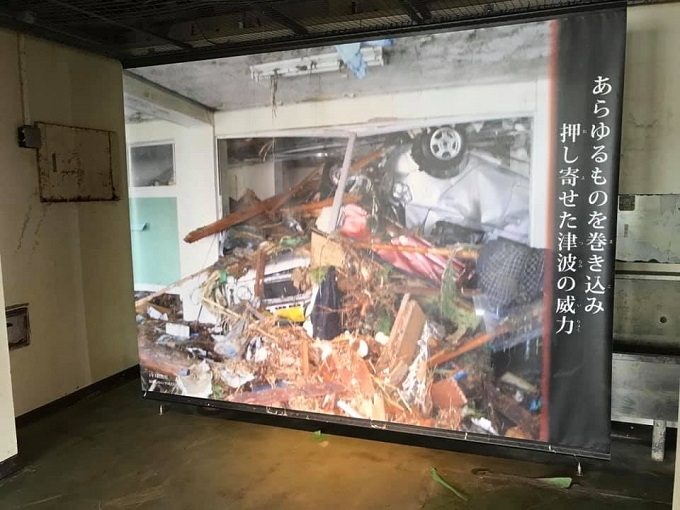 Earthquake Heritage Arahama Elementary School. Visiting the ruins of school buildings destroyed by the tsunami, I was confronted by the terrifying force of the disaster
Earthquake Heritage Arahama Elementary School. Visiting the ruins of school buildings destroyed by the tsunami, I was confronted by the terrifying force of the disaster Since 2014, I have been lecturing on literature, films and artworks influenced by the Great East Japan Earthquake disaster at my institute in the Tokyo region. For many of my students, the time since the disaster is longer than their life leading up to the disaster, which struck when they were eight years old, and more and more of them feel they are in a "history" lecture rather than encountering a contemporary cultural phenomenon in real time.
Therefore, I sometimes show them two types of works and ask them to compare. One type is documentaries about the disaster, diaries of people who were there and so forth. The other type is works of entertainment that have the Great East Japan Earthquake disaster as a theme. The former include 311 directed by Yasuoka Takaharu, Nuclear Nation directed by Funahashi Atsushi, and Hiai and 3/11 - Doukoku no kiroku edited by Kanebishi Kiyoshi. The latter are works such as Shin Godzilla directed by Anno Hideaki, Your Name. directed by Shinkai Makoto and The Land of Hope directed by Sono Sion.
What is the difference between the two types, the former reflecting something close to the facts and the other, which (sometimes) metaphorically weaves history, disaster and a message into a fictional work that is an easily-digestible entertainment?
Students are often blown away by the "reality" of documentaries and diaries about the disaster. They love them and say it is vital that the stories are told. They also empathize with the sadness expressed in diaries. I am convinced it is making them feel something at a deep level.
Nevertheless, the same cannot be said for taking their own initiative to watch a documentary or to read the testimony of survivors. They are more likely to have watched movies like Shin Godzilla or Your Name.
In this tension between fact and fiction, I sense increasingly that the essence is to be found in the relationship between disasters and stories.
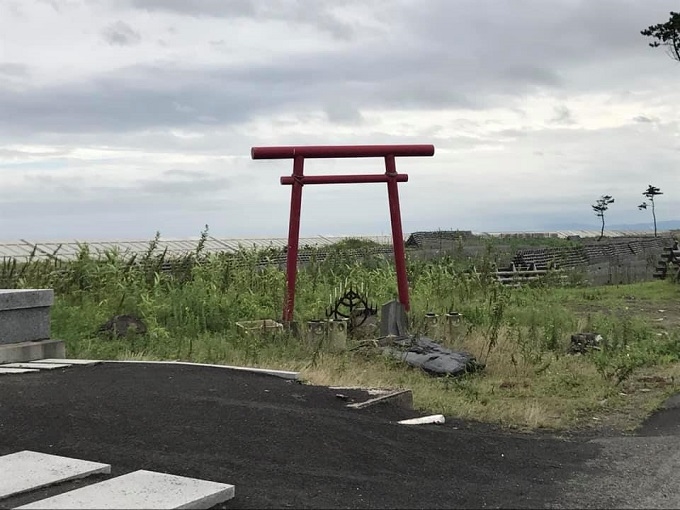 Arahama, Sendai. The village is destroyed. As pictured, there are many memorials and places for prayer without a particular religion or method indicated
Arahama, Sendai. The village is destroyed. As pictured, there are many memorials and places for prayer without a particular religion or method indicated The importance of not forgetting, the need to sustain memory and the imperative of preparing for disaster: people tend to approve of such noble ideals. However, most people would not seek out a documentary about the disaster themselves, or go to visit the scene of the disaster in person. It is a rare human being who would want to use their free time to sit down to earnestly study, to consider or to feel the heartache of looking over the desolate ruins of the disaster zone. The proof can be found in the ratings for TV shows about the disaster that screen every March and in the sales of the documentaries and diaries. It is sad, but this is the reality.
However, this is natural. It is the desire of most humans to spend their time and money on entertainment that is fun and makes them feel good. Calling this "disgraceful" will not get us anywhere.
Therefore, another strategy comes into view - that of movies like Shin Godzilla and Your Name. that harness entertainment devices and appeal to the masses. By mixing in metaphors and symbols of the earthquake and the nuclear disaster, they expose the audience to fragments of the truth as they are entertained, rather than lecturing from on high.
Given the incredible complexity and diversity of the facts of the disaster, there are some things that defy being told as a "story." The experiences of survivors, because of their complexity, cannot be smoothly understood by others at the same level of detail.
Here is a story I heard in my travels to the disaster zone for the disaster literary magazine Rarahora. A group of elderly women got together on the coast where the tsunami hit. Laughing, one recalls, "When the tsunami came, I let go of a child's hand."
When you hear something like that, can you process it right away? On social media today, it might blow up as "a warped sense of humor, laughing about children dying." Yet it can be imagined that meeting fellow survivors and sharing laughter is the only way of sublimating the sadness and suffering - that this "laughter" might be a way of overcoming it. In such a situation with such emotions, all we can do is try to put ourselves in their shoes, to tremble at their ferocity.
There is a major challenge in conveying external phenomena that exceed our own experience and imagination, in conveying the inner lives of those who lived through them.
We are now in a post-truth era. We criticize fake news and we talk about the importance of "facts," but perhaps what is misunderstood is that we have more trouble absorbing things that are actual facts.
One more example, this is about the natal home of the late novelist Muroi Mitsuhiro. The house was deep in the mountains of Fukushima Prefecture, and they farmed tobacco and bred silkworms. Muroi's grandmother did not much like rest and relaxation and felt people who could no longer work were of little value. In keeping with her "philosophy," as soon as she could no longer work, she strung herself up in the barn.
What does this mean? What was the context? For us it is incomprehensible. However, it is just a fact. This kind of reality writer Sakaguchi Ango called "the hometown of literature." It "makes you give up trying to understand it on a conceptual level" and makes the reader feel "pushed away." Herein lies something like "absolute solitude - the absolute solitude that survival itself impregnates."
This is why, as we live our day to day lives with an understanding of things that matches our existing conceptions and ideas, those "facts" represent a significant burden on cognitive ability. Our imaginations are limited to the outlines set by things such as our experience and the fiction that we have encountered. Our minds love things we can smoothly understand, so facts that go beyond this are difficult to understand or accept.
How can we bridge this gap? How can we convey the otherness of "facts" or "realities" that exceed our imagination and understanding? How can we create stories that contain realities that exceed easily-understood "stories"? I would like to make this the starting point in thinking about the significance of stories.
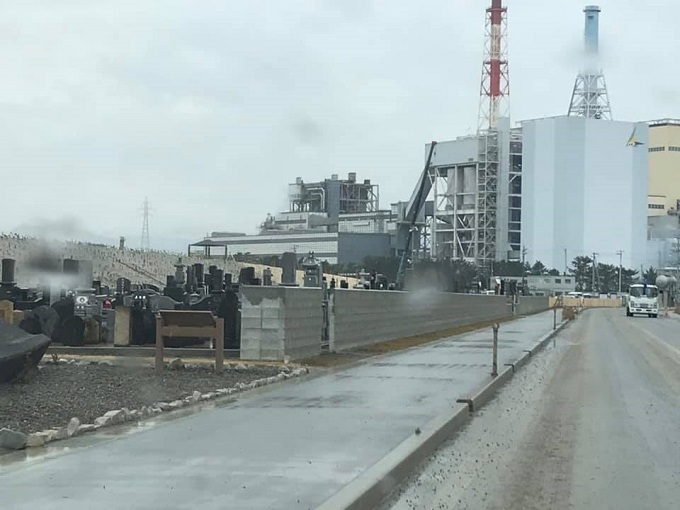 Nakoso IGCC power plant near Onahama, Fukushima Prefecture. It runs on cutting-edge integrated coal gasification combined cycle technology. My guide is local activist Komatsu Riken. The contrast of the tsunami damage, the power plant and the tombstone is impressive
Nakoso IGCC power plant near Onahama, Fukushima Prefecture. It runs on cutting-edge integrated coal gasification combined cycle technology. My guide is local activist Komatsu Riken. The contrast of the tsunami damage, the power plant and the tombstone is impressiveThere is such a passage in Chernobyl Prayer/Voices from Chernobyl, a collection of stories from survivors the nuclear disaster by Nobel Prize in Literature awardee Svetlana Alexievich. A woman describes the accident, which killed her husband who died of radiation poisoning after going to the power plant to fight the fire and caused her unborn child severe disability. What comes to the fore is her dedication and love for her husband. It is a very emotional story, but at the end she says:
"(The nuclear plant workers) have all got serious illnesses, disabilities...they keep dying. It's a quick death, they die on the go. They'll be sitting on a bench and just collapse. They'll be walking along and just collapse...Or standing at a bus stop. They're dying, but no one ever really questioned them properly. About what we went through, what we saw. People don't want to hear about death, all these terrible things. But I've told you about love. About how much I loved." (Penguin Books)
When I first read it, I did not understand the meaning of what she said after the last "But." I read it again and again. I eventually understood that she was implying that even though "death" and "terrible things" were inescapable reality, a lot of people would not want to hear about it, so she was conveying it by turning it into a love story instead.
I interpret this as her way of conveying to happy people who are not survivors of some disaster, who would tend not to think about or imagine such things - by turning her experience as a survivor into a story.
To repeat, "realities" and "facts" are like unprocessed fragments. Throwing them up as they are without time sequencing or causality means they cannot be readily understood and absorbed by people. Therefore, a "story" is required.
A narrative makes things easy to understand, but the details of facts and realities get lost along the way. This trade-off between the story and the facts is likely to be a challenge forever.
Of course, a story is a double-edged sword. You lose the complexity of real life and details, and things are simplified. Sometimes production elements intrude. What is included and the points of emphasis are choices that are contrived. Put a foot wrong and you can stray close to disinformation or propaganda. Some may even say there is no real difference between these and a story.
So, how about the relationship between the COVID-19 pandemic and stories? Of course, there have been many stories told about pandemics. The Andromeda Strain by Michael Crichton, Virus by Komatsu Sakyo, Contagion by Steven Soderbergh, not to mention all those zombie pandemics.
However, in this pandemic, real life has thrown up the totally unexpected, such as the government trying to distribute "meat vouchers," or the "Go To" campaign to encourage travel. For example, before the coronavirus came along, would you think the script for a pandemic movie in which the government says it will "hand out meat vouchers" would be approved in the planning meeting? I doubt it. People would feel it was unrealistic, an inane joke. But it happened in real life. A number of writers admitted that reality had surpassed their own imaginations.
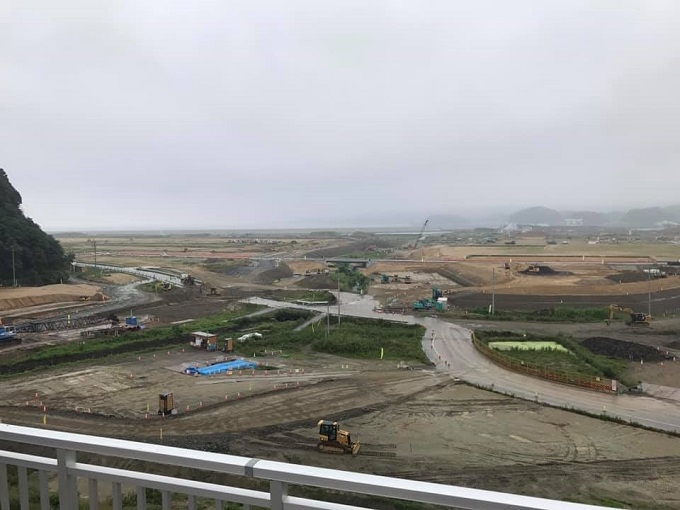 Rikuzen-Takada, Iwate Prefecture. The town was destroyed and is now undergoing elevation work. Sense of reality is shaken by the sheer scale of the works and construction of a new town
Rikuzen-Takada, Iwate Prefecture. The town was destroyed and is now undergoing elevation work. Sense of reality is shaken by the sheer scale of the works and construction of a new town In the COVID-19 pandemic, many have uttered the name of Tsutsui Yasutaka. Tsutsui is a novelist who by chance was the subject of my doctorate. He is famous for his "nonsense" style. "Sense," as in meaning, order, reason. The upending of "reality" since the outbreak of COVID-19 is like the black humor of Tsutsui's novels.
The absurd of Tsutsui, in which sense is broken to the point of slapstick and there is neither meaning nor order, would never have been thought to be "realism." Many of his readers may feel that "this reality" is now a case of life imitating this kind of novel.
Tsutsui Yasutaka had a deep respect for Sakaguchi Ango, the writer mentioned above. Ango said that facts that push us away cause "laughter." And Tsutsui is also a writer who focuses on the comedy of nonsense.
Looking at the statement that the "reality [of many people] is like a Tsutsui Yasutaka [novel]," here is what I thought: the slapstick and nonsense depicted by Tsutsui is an allegory for how people and society might behave in a real emergency or unusual situation. Tsutsui, who lived through the Second World War and the postwar reconstruction, adopted slapstick and black humor as his way of conveying the truth and reality of this experience, and chose the unreal SF as his genre.
Tsutsui was influenced by surrealism, and it was the subject of his graduation thesis. Surrealism was a movement born out of the shocking new circumstances of the First World War where the battlefields were scenes of massacre by tanks and poison gas. It attempted to express that which exceeded the scope of the existing order in art. Tsutsui did not experience the World War I, but he was alive during the Second World War as an infant.
His metafiction - not hyperreality - was perhaps his way to express facts that pushed us away and were stranger than fiction. Our reality- incomprehensible, ridiculous and exhausting - certainly resembles this.
(For the record, this is not a criticism of the Japanese government. I understand the inevitability, the aims and the good intentions of the meat coupons and the Go To campaign, because I myself took advantage of the latter campaign to travel. It is just that there is a gulf between what we expected a pandemic to be like in fiction and what actually happened, which structurally caused laughter.)
From the perspective of realism, the style normally seen as the most removed from fact and reality can seem close to fact and reality in an emergency, something that has caused me to think deeply. It is not that SF foresaw anything. Rather, we should see that the devices and allegories of SF are used to portray a certain type of truth (a real emergency that might sound unreal in normal times).
It is easy to imagine that 20 years down the track, once the pandemic is completely over, it will be fairly difficult to explain the experience to the next generation, for example our own children, and for them to listen.
The global pandemic has inflicted an economic shock and killed millions of people, but the Olympics will (for the time being) be held, there is a Go To travel campaign and everyday life is relatively calm and peaceful. Nevertheless, many people have lost their job or business, yet the share market and real estate have skyrocketed, as have the profits of the tech industry. It seems the government did not take measures that were consistent or based on science, yet on a global level the number of cases and deaths in Japan is low. And when the vaccines arrived, our logistics capacity suddenly expanded and the vaccine rollout progressed very well.
Honestly speaking, I have no clue as to the script that would make it easy to understand. You could weave a "story about fighting and overcoming the virus," but that would be fairly remote from my own lived experience. I do not feel it would convey very well the "sense of the times."
This tension between fact and fiction may be "the origin of modern literature," something unchanged since the time of Cervantes' Don Quixote.
Don Quixote is a novel about an old man in a remote village of Spain who reads too many chivalric romances and thinks he is a hero, but here, affection for a person who cannot live without confusing fact and fiction is mixed with criticism of this farcical approach. During this confusion of fact and fiction, old Don Quixote enjoys some rather exciting adventures and is full of life. As soon as he wakes up to reality though, he loses heart and dies. The allegory is clear.
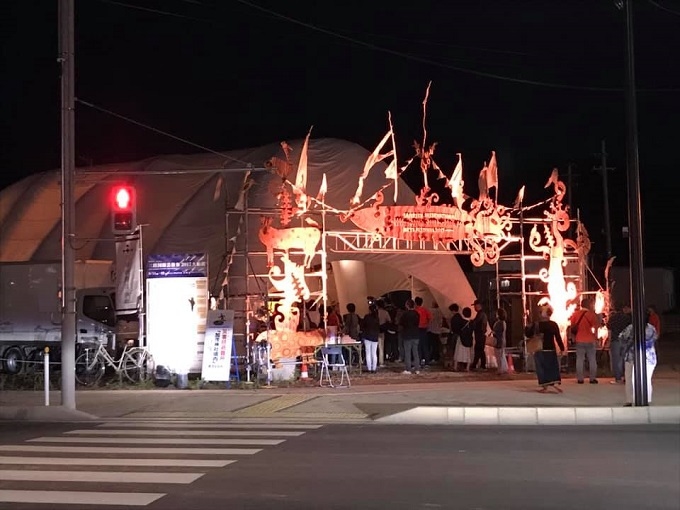 The Sanriku International Arts Festival in Ofunato, Iwate Prefecture. When I first saw the traditional "deer dance," I was intrigued by its momentum and energy. The feverish excitement of the local people was incredible and I felt I was communing with the culture from the bottom of my heart
The Sanriku International Arts Festival in Ofunato, Iwate Prefecture. When I first saw the traditional "deer dance," I was intrigued by its momentum and energy. The feverish excitement of the local people was incredible and I felt I was communing with the culture from the bottom of my heartIto Seiko deals with this issue in Radio Imagination. Writers volunteering in the disaster zone are having an argument. Is it good or bad to "imagine" the voices of the dead? Some say it is "unscientific sentimentality," or that it is "not a real sound." Others argue we cannot stop bereaved families or others from imagining these voices.
This can be rephrased as a question about how we should think about a narrative in which the dead go on living. In fact, to take the research of Kanebishi Kiyoshi, it appears that many people in the zone affected by the Great East Japan Earthquake disaster believe that the dead do go on living and growing older. When I visited the region, there were itako (female spiritual medium) around.
There was a time in the past when narrative was criticized. By "narrative," they meant the attempt to bring schematic understanding of the world and phenomena. A typical example would be stereotyping or binary thinking that divides everyone into either friends or enemies. There was a radical movement inspired by the idea that if these patterns of "narrative" knowledge and understanding could be broken down, and if the understanding of people who have been poisoned by a narrative could be changed, the world could become a better place.
Based on this kind of critique of narrative and the debate over the impossibility of representation as shown in works like Claude Lanzmann's Shoah, Radio Imagination is a novel that takes the direction of advocating "imagination" and "story" rather than hewing too closely to the facts.
Narrative can be dangerous. However, without any story at all, just as Don Quixote returned to sanity and his identity as despondent old man Alonso Quijano, the cruel and meaningless fact and reality, and bleakly haphazard, may be unbearable.
Ango called facts that push us away "the hometown of literature." This is well understood as "literature starts from here." "Our hometown is our cradle, but the work of an adult is not about returning home."
In this tension with such a vacuous "hometown," story in the broadest sense - perhaps including our view of life and death, myths and religion - have been needed, developed and operated as such.
Regarding my comment that facts are poorly understood as facts alone, I am no exception. As I write this in June 2021, the facts are that almost 200 million people have been infected with COVID-19 and nearly 4 million have died from the disease. This is not something that I have fully comprehended.
It may be that a pandemic involving a virus with global infectivity is on a scale too large for the human mind to fully grasp. A virus is invisible to the naked eye and at the level of everyday life, the world appears calm. That is why we lose touch with the situation and the statistics we see in the news: the situation does not sink in because the instinctive brain and the intellectual brain are separate.
However, with a movie for example, we are likely to fully comprehend a scenario in which a single human being catches COVID-19 and dies, and to become emotionally engaged. More than the statistic of 4 million, taking the path of emotional engagement by telling a story of a single person is more persuasive for our minds. Seeing a pile of dead bodies on the street or patients struggling painfully in hospital might fill us with more alarm, but in this case, concern and fear can grow to become overwhelming, so this may be the wrong way to go.
A narrative works to link intellectual understanding to making sense according to the existing fault lines of our knowledge. Human civilization has developed to a high level of sophistication and complexity, leading to a serious disconnect between facts, which can be understood intellectually, and things that people understand from firsthand experience in the course of their everyday lives. When it comes to expert knowledge, there are few people who can understand all of it. That is why conspiracy theories, which simplify the world into a story that connects the pieces, are so prevalent at the moment.
If I may mention a personal matter, I recently took out a mortgage. I studied up on how it works, finance and the economy, but to tell the truth, I felt it to be too complicated to understand. The economy is vital and it is knowledge that is essential to living, yet I could not make head nor tail of it. I thought I just had to "trust" the person explaining it to me. It was then that I understood how a person can fall down the rabbit hole of conspiracy theories.
Yet paradoxically, the rise of conspiracy theories demonstrates the aspiration of people to have a narrative. We are beings who seek systematic understanding of "this world," who seek meaning. Herein, perhaps, lies the meaning of creating new stories, literature, art and culture.
Given that human genes have not changed significantly, and neither have the patterns enjoyed by our minds, the basic structural elements of folk tales identified by Vladimir Propp and the archetypes of Carl Jung may have universal power. Nevertheless, we still need to create novelty in the modern age, because the constant changes rendered to our environment and circumstances by humans produce a desire for things to "make sense" among the people. And this is certainly necessary.
Now, will any kind of story fit the bill? No, it must be a believable narrative. In an era in which everyone is skeptical and cynical about information, to the point that conspiracy theories spread like wildfire, how are we to earn trust? I want to believe this is something that each of us must create desperately, genuinely, honestly, faithful to our true feelings.
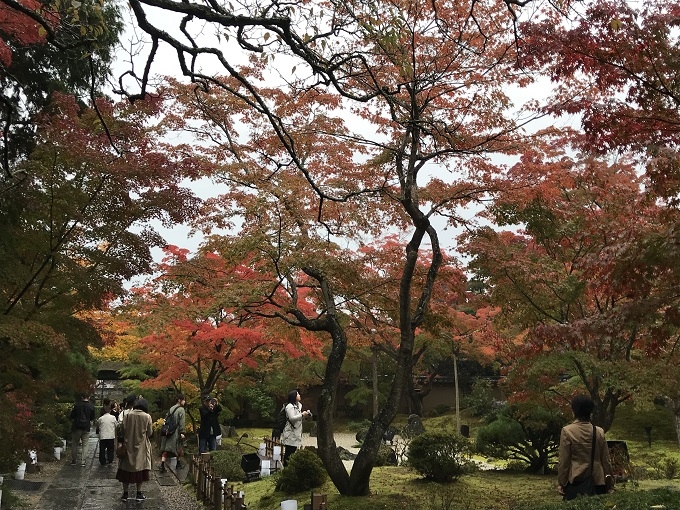 Matsushima, Miyagi Prefecture. Aboard the tourist ferry to Shiogama, the guide was talking about losing his family in the disaster. Having listened to the story, guys who were drinking rowdily were ready to support the economy by buying a lot of local seaweed
Matsushima, Miyagi Prefecture. Aboard the tourist ferry to Shiogama, the guide was talking about losing his family in the disaster. Having listened to the story, guys who were drinking rowdily were ready to support the economy by buying a lot of local seaweedAsking himself why he writes novels when masterpieces like Dostoyevsky's novels already exist, Oe Kenzaburo came to the answer that "it is probably to tell other people living in the same period of time how I am living my life."
This is a passage found in his book, Imagination of the Atomic Age. To rephrase, since the bombing of Hiroshima and Nagasaki, it has been mutually assured destruction, or the permanent arming of nuclear weapons aimed at one another, that has maintained peace and equilibrium under a Cold War. We could say that this was an attempt to create a story to make sense of the fact that we were living in which a country that was subjected to atomic bombs was rushing to Americanize and develop into a scientific and technological powerhouse.
Never before had humanity lived in a world in which weapons capable of destroying us had been permanently aimed at us. Oe Kenzaburo was not trying to build a model to understand humanity, the earth, history, life or space, including such a world. He said, "As a writer of this period, no matter how mediocre I may be compared to Dostoyevsky, no matter how many mistakes I make as a writer, there must be some meaning in that very mediocrity, those very mistakes being communicated as a message to others living in the same period."
Understanding this world and this situation requires us firstly to make a cognitive effort. Surely more people can empathize with the fruits of such a struggle. Today, we should strive to create a story to "understand" this pandemic. Rather than an attitude of top-down imposition or lecturing, I feel that this approach connects emotionally with people.
This is something I take from the research on postwar Japanese subcultures and mass culture too. I think that the reason these stories reached people around the world is because they assuaged the existential doubts and fears of those living in "new environments" such as postwar Japan and the information society. In other words, these stories crystallized the cognitive effort to understand life in the new environment and resonated with those living under the same conditions. They served as a model for understanding life and thriving in the new environment.
It is through the fruits of this struggle - works of art - that the soul of an individual living as a physical body in this world, can capture the hearts of others living in similar circumstances, make allies across cultures, national borders and time, to ultimately create something like a spiritual community.
Therefore, rather than frameworks, appeals or theories telling people how to understand or how to speak, it is better to respect freedom. This is because nobody knows the answers ahead of time in this continuous work of coming up with cognitive frameworks and methodologies to address new circumstances, and repression is bad for its productivity.
When it comes to the relationship between disasters and stories, I have a dream. Is it not through fiction, which sits in tension with "real life," that we find the shared spirit underpinned by our "absolute solitude - the absolute solitude that survival itself impregnates," that - in a contradiction in terms - generates a seemingly impossible solidarity? "The absolute solitude of survival" is the foundation, so does this not open the way to a shared spirit across the boundaries of culture, religion, time and nations? Could we all lead the world to a higher plain through mutual respect of each other's "solitude of survival"? Or is this just a stale aesthetic utopianism? Could it be the basis for moving beyond conflict and hatred, overcoming global challenges?
Arthur Schopenhauer said that sharing of the suffering of others is the basis of morality. From my experience of watching the reaction of students to various works, I do not doubt that this is what happens in the human heart. Regardless of where and when, this is true. It is surprising, and I believe it is a sign affirming my belief in the future of humanity and human beings.
Submitted June 2021
All photos by author
Related Articles
Back Issues
- 2025.7.31 HERALBONY's Bold Mis…
- 2024.10.25 From Study Abroad in…
- 2024.5. 2 People-to-People Exc…
- 2022.11. 1 Inner Diversity<3> <…
- 2022.9. 5 Report on the India-…
- 2022.6.24 The 48th Japan Found…
- 2022.6. 7 Beyond Disasters - …
- 2021.3.10 Crossing Borders, En…
- 2020.7.17 A Millennium of Japa…
- 2020.3.23 A Historian Interpre…


